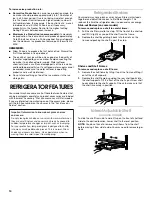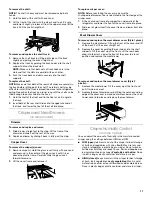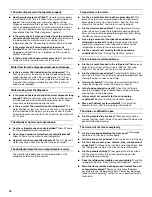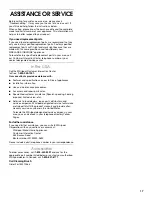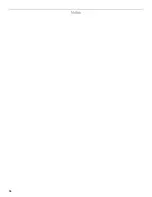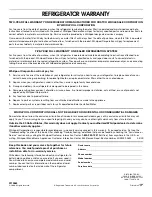
5
Electrical Requirements
Before you move your refrigerator into its final location, it is
important to make sure you have the proper electrical
connection:
Recommended grounding method
A 115 Volt, 60 Hz., AC only 15 or 20 ampere fused, grounded
electrical supply is required. It is recommended that a separate
circuit serving only your refrigerator be provided. Use an outlet
that cannot be turned off by a switch. Do not use an
extension cord.
NOTE:
Before performing any type of installation, cleaning, or
removing a light bulb, turn the control (Thermostat, Refrigerator
or Freezer Control depending on the model) to OFF and then
disconnect the refrigerator from the electrical source. When you
are finished, reconnect the refrigerator to the electrical source
and reset the control (Thermostat, Refrigerator or Freezer Control
depending on the model) to the desired setting.
Connecting to a Water Source
Read all directions carefully before you begin.
IMPORTANT:
■
If you turn the refrigerator on before the water line is
connected, turn the ice maker OFF.
■
All installations must meet local plumbing code requirements.
■
Use copper tubing and check for leaks. Install copper tubing
only in areas where temperatures will remain above freezing.
Tools required:
Standard screwdriver,
⁷⁄₁₆
in. and
¹⁄₂
in. open-end
wrenches or two adjustable wrenches,
¹⁄₄
in. nut driver and drill
bit, hand drill or electric drill (properly grounded).
NOTE:
Your refrigerator dealer has a kit available with a
¹⁄₄
in.
(6.35 mm) saddle-type shut-off valve, a union, and copper tubing.
Before purchasing, make sure a saddle-type valve complies with
your local plumbing codes. Do not use a piercing-type or
³⁄₁₆
in.
(4.76 mm) saddle valve which reduces water flow and clogs more
easily.
Cold water supply
Connect the ice maker to a cold water line with water pressure
between 30 and 120 psi. If you have questions about your water
pressure, call your utility company.
Connecting to water line:
1.
Unplug refrigerator or disconnect power.
2.
Turn OFF main water supply. Turn ON nearest faucet long
enough to clear line of water.
3.
Locate a ½ in. to 1
¹⁄₄
in. (12.7 mm to 3.18 cm) vertical COLD
water pipe near the refrigerator.
NOTE:
Horizontal pipe will work, but drill on the top side of
the pipe, not the bottom. This will help keep water away from
the drill and normal sediment from collecting in the valve.
4.
Determine the length of copper tubing you need. Measure
from the connection on the lower left rear of refrigerator to the
water pipe. Add 7 ft. (2.1 m) to allow for cleaning. Use
¹⁄₄
in.
(6.35 mm) O.D. (outside diameter) copper tubing. Be sure
both ends of copper tubing are cut square.
5.
Using a grounded drill, drill a
¹⁄₄
in. hole in the cold water pipe
you have selected.
6.
Fasten the shut-off valve to the cold water pipe with the pipe
clamp. Be sure the outlet end is solidly in the
¹⁄₄
in. drilled hole
in the water pipe and that the washer is under the pipe clamp.
Tighten the packing nut. Tighten the pipe clamp screws
carefully and evenly so washer makes a watertight seal. Do
not overtighten or you may crush the copper tubing.
7.
Slip the compression sleeve and compression nut on the
copper tubing as shown. Insert the end of the tubing into the
outlet end squarely as far as it will go. Screw compression nut
onto outlet end with adjustable wrench. Do not overtighten.
8.
Place the free end of the tubing in a container or sink, and
turn ON the main water supply. Flush the tubing until water is
clear. Turn OFF the shut-off valve on the water pipe. Coil the
copper tubing.
Connecting to refrigerator:
1.
Attach the copper tube to the valve inlet using a compression
nut and sleeve as shown. Tighten the compression nut. Do
not overtighten. Use the tube clamp on the back of the
refrigerator to secure the tubing to the refrigerator as shown.
This will help prevent damage to the tubing when the
refrigerator is pushed back against the wall.
2. Turn shut-off valve ON. Check for leaks. Tighten any
connections (including connections at the valve) or nuts
that leak.
WARNING
Electrical Shock Hazard
Plug into a grounded 3 prong outlet.
Failure to follow these instructions can result in
death, fire, or electrical shock.
Do not use an extension cord.
Do not use an adapter.
Do not remove ground prong.
1. Cold Water Pipe
2. Pipe Clamp
3. Copper Tubing
4. Compression Nut
5. Compression Sleeve
6. Shut-Off Valve
7. Packing Nut
1. Tube Clamp
2. Copper Tubing
3. Compression Nut
4. Value Inlet










